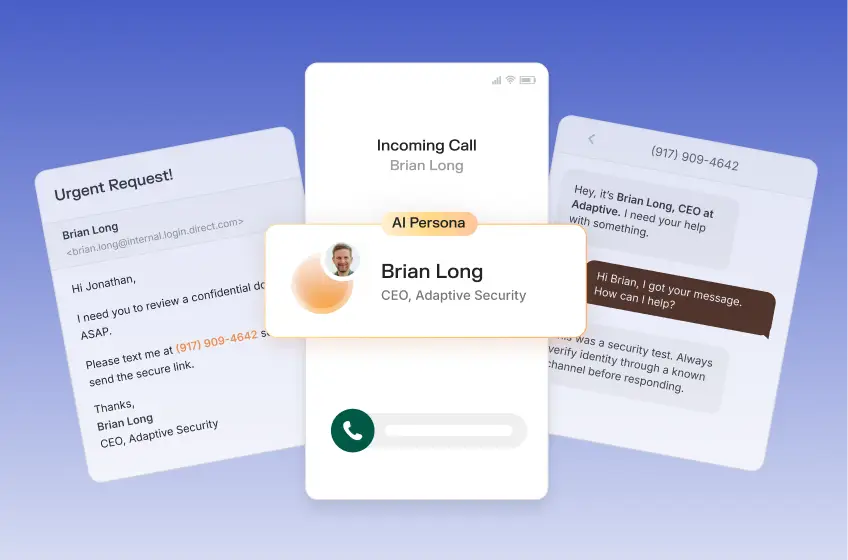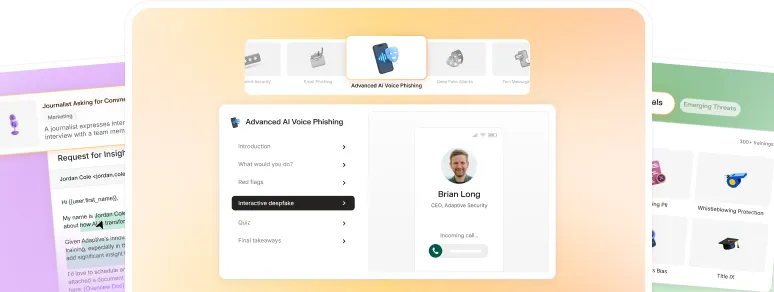AI phishing is up 4,151% since the launch of OpenAI’s ChatGPT, and cloud intrusions have risen by 136% as attackers target AI-driven systems used by organizations.
In this environment, the human firewall is an organization’s strongest layer of defense — or a massive liability. IT and security teams are recognizing that generic, one-size-fits-all security awareness training falls short, leaving every employee vulnerable to AI threats.
Role-based training for AI threats is the new standard. It’s a structured, intelligent approach that maps specific threats, security policies, and hyper-realistic phishing simulations to individual job roles and functions.
This methodology is built on a deep understanding of each employee’s data access, system privileges, daily workflows, and unique exposure to risk. Unlike generic programs that offer the same content to a CEO and a junior marketer, role-based training delivers relevant, contextual, and actionable guidance where it’s needed most.
Security leaders need a playbook for designing and scaling a next-generation security awareness training program.
By leveraging role-based training and hyper-realistic phishing simulations, you prepare every employee — from finance and DevOps to the C-suite and HR — for the sophisticated deepfake, vishing, and smishing attacks they’re now guaranteed to face.
Why Role-Based Training is Important Right Now
AI is accelerating both business value and attacker capability at an unprecedented rate. Cybercriminals are using generative AI to craft flawless, highly personalized social engineering campaigns that easily bypass legacy security controls and fool employees trained on only generic red flags.
To counter AI threats, you need a training program that’s AI-driven and role-based.
AI-powered threats your workforce faces
Attackers are weaponizing a full suite of AI tools to target employees with tailored attacks across multiple channels; therefore, understanding this threat landscape is the first step toward building an effective training program.
Here’s a quick recap of the most common AI-powered threats:
- Email Phishing: AI is used to create linguistically perfect and contextually aware email lures at scale.
- Example: A lure spoofs a popular marketing analytics platform, using industry-specific terminology to trick a demand generation manager into ‘re-authenticating’ their account and thus surrendering credentials.
- Vishing (Voice Phishing): AI voice cloning replicates another employee’s voice from just a few seconds of audio.
- Example: An accounts payable specialist receives a call from the ‘CFO,’ whose cloned voice creates urgency to approve a large, last-minute wire transfer for a confidential acquisition.
- Smishing (SMS Phishing): Text messages impersonate a colleague during a real-time conversation on mobile devices.
- Example: An employee receives a text message impersonating HR, directing them to a fake portal to update their payroll information, leading to credential and identity theft.
- Deepfakes: AI-generated video, images, and audio used to impersonate individuals with their likeness manipulated in real time.
- Example: A project manager is invited to a last-minute video call where a deepfake of their director instructs them to grant emergency access to a critical system to a ‘new consultant.’
- Prompt Injection & Model Abuse: Attackers craft malicious prompts that cause internal or public AI systems to bypass security controls, exfiltrate sensitive data, or reveal proprietary secrets.
- Example: A developer using an internal AI coding assistant is tricked into using a malicious code snippet from a public forum, which contains a hidden prompt injection that leaks the company’s API keys.
- Data Leakage: Unintentional exposure of sensitive information by employees.
- Example: An employee pastes customer data and internal strategy documents into a public AI model to summarize them, unknowingly adding that proprietary information to the model’s training data.
These threats, like all types of phishing attacks, lead to devastating business outcomes, including financial fraud, data exfiltration, reputational damage, and operational downtime.
Limits of generic security awareness training
Traditional security awareness training programs weren’t designed for the speed, scale, and sophistication of AI-enhanced attacks.
Their limitations are now a risk, too:
- Learning Decay: Humans forget around 70% of new information within days without active reinforcement. Annual or infrequent training sessions are fundamentally ineffective for building the lasting habits needed to combat persistent AI threats.
- Lack of Role Relevance: A one-size-fits-all module sent to the entire company can’t address the unique risks faced by different departments and roles. It misses specific workflows, tools, and dynamics that cybercriminals exploit.
- Outcome Gap: The goal of training is behavior change, not completion. Generic training yields marginal improvements, whereas immersive training with simulations is highly effective in reducing security incidents.
Notice that these limitations reveal that generic training programs create a false sense of security, leaving the entire organization vulnerable to attacks.
Shadow AI risks and policy alignment
An often-overlooked risk is the rise of shadow AI, the unsanctioned use of AI tools and models by employees. From public chatbots to browser extensions, it creates massive security blind spots.
Shadow AI leads to uncontrolled data flows and the use of unvetted models, exposing the organization to risks like data leakage, intellectual property (IP) exposure, compliance violations, and even insider threat amplification.
Mitigating this requires clear policies reinforced through role-based training:
- Acceptable Use: Training defines which AI tools are approved and for which specific use cases. It should mandate secrets management for any prompts and forbid the use of unapproved AI.
- Data Minimization: Training prohibits employees from pasting sensitive corporate or customer data into external, public AI models. Provide safe, approved workflows for redacting sensitive information.
- Incident Reporting: Training highlights a simple, fast, and blameless process to report suspicious AI behavior. This turns a potential crisis into a source of threat intelligence.
Integrating these clear policy directives into role-based training modules transforms shadow AI from an unmanaged risk into a governed tool for innovation.
Mapping Roles to AI Threats & Learning Objectives
Role-based training is built on a simple, repeatable framework: map employee roles to their privileges and data access, identify the most likely AI threats they’ll face, and define measurable learning objectives to mitigate those risks.
Role taxonomy and risk tiers
Create a role taxonomy that groups employees into risk tiers based on data sensitivity and system privileges. This allows you to scale training without creating thousands of unique plans.
Here’s the framework visualized into a simple table that maps risk tiers to common roles and their associated AI threats:
This high-level taxonomy provides a strategic foundation for prioritizing training efforts. From here, security leaders can drill down to map specific threats to the daily functions of each department.
Threat mapping for business functions
With risk tiers established, map specific AI-driven attack scenarios to business functions. This ensures that the training content is directly relevant to an employee’s daily work.
Adaptive Security simplifies threat mapping for business functions by providing pre-built threat models tailored to various roles, which can be fully customized to meet an organization’s specific needs.
The matrix below provides a starting point for this mapping:
Mapping threats to roles in this way makes the risks tangible and directly relevant to employees’ day-to-day responsibilities.
Learning objectives aligned to phishing attacks
Finally, define measurable, role-specific learning objectives. These should describe observable behaviors that demonstrate an employee’s ability to counter a threat.
Below are example learning objectives for several types of phishing attacks:
- Email Phishing: Upon receiving a simulated email, a Tier 2 employee will identify and report at least three AI-tailored phishing indicators (like subtle domain spoofing, unusual urgency, and unexpected request) in under 1 minute using the ‘Report Phishing’ button.
- Vishing: When receiving a voice request for a payment over $10,000, a Tier 1 finance employee will correctly authenticate the request using a known, out-of-band backchannel before taking any action.
- Smishing: A Tier 2 employee receiving an SMS message requesting a payroll or multi-factor authentication (MFA) change will validate the request’s legitimacy by navigating directly to the official company portal, rather than clicking the provided link.
- Deepfakes: When faced with an unexpected video request from a senior leader, a Tier 1 or 2 employee will correctly apply a three-step media verification workflow (context check, channel verification, and challenge phrase) before proceeding.
These objectives transform abstract security goals into concrete, observable behaviors that can be practiced, measured, and improved over time.
Build a Scalable Role-Based Training Program
A modern, scalable training program is built on a three-layer architecture that combines identity-driven segmentation, personalized content delivery, and intelligent orchestration of phishing simulations.
Automate role segmentation
Manual group management is not scalable. To deliver role-based training effectively, you need to automate role segmentation by integrating your training platform with your identity sources.
- Sync with HRIS & IDP: Automatically sync data fields like department, role title, manager, location, and privilege level from your HRIS (such as Workday) or identity provider (such as Okta or Google Workspace) to map users to dynamic training groups. Adaptive Security, for instance, integrates seamlessly with many of these platforms.
- Implement Change-Driven Updates: The system should automatically adjust an employee’s training assignments when their role changes, their privileges are elevated, or they gain access to a high-risk application.
Automating segmentation not only saves administrative overhead but also ensures that training remains aligned with an employee’s current role and risk profile, which is what makes legitimate personalization at scale possible.
Design content by role, threat, and proficiency
Your content library should be fully customizable, allowing you to take core content for each threat type and use a next-generation platform, such as Adaptive Security, to personalize it based on role and proficiency.
- Microlearning: Content should be delivered in short, digestible lessons (7 minutes or less) that focus on a single, atomic concept and are accessible on mobile devices.
- Scenario-Based Learning: Training is most effective when realistic, so use real email examples, authentic AI voice clones, and even deepfakes of your actual executives that are mapped to role-specific workflows.
- Relevant, Timely Content: This is where Adaptive Security excels, offering AI Content Creator to build virtually any type of training module from scratch in moments, mirroring the fast-evolving AI threat landscape and ensuring training is always up-to-date.
A well-designed content library, combining modular microlearning with realistic scenarios, forms the educational core of the training program.
Orchestrate phishing simulations at scale
Phishing simulations are pivotal to turning knowledge into behavior; therefore, a regular cadence of varied and challenging simulations is essential for role-based training.
- Spaced Reinforcement: Schedule repeated exposure to key risks at various intervals. This strategy is proven to counter the forgetting curve and build long-term retention.
- Vary Channels & Difficulty: Don’t just send emails. A well-run program orchestrates multi-channel phishing simulations. The difficulty should adapt, starting with a baseline and progressively increasing sophistication.
By orchestrating simulations with this level of intelligence and variety, organizations can effectively build and test their human firewall.
Deliver Training for AI Threats Safely
Personalization is critical to engagement and retention, but it must be balanced with a strong commitment to privacy and data protection.
Adaptive assessments and spaced reinforcement
Static, one-time tests are poor indicators of true understanding. A modern program uses adaptive and continuous assessment.
- Adaptive Assessment: A testing method that dynamically adjusts the difficulty and content of training based on an employee’s performance. It allows you to pinpoint an individual’s specific knowledge gaps and proficiency level with far greater accuracy.
- Spaced Reinforcement: As mentioned earlier, this learning strategy involves revisiting key concepts at increasing intervals to interrupt the forgetting curve and embed knowledge in long-term memory.
By starting with a diagnostic assessment and then using adaptive technology to target weak skills and escalate complexity, you create a truly personalized and effective learning path for every employee.
Adaptive Security shines here, operationalizing these concepts through a diagnostic-first approach that targets weak skill sets and escalates complexity based on employee success.
Privacy, data minimization, and model governance
As you use AI to train your employees, remember to adhere to strict privacy-by-design principles.
- Data Minimization: Collect and process only the data that is strictly necessary for training segmentation and analysis. Retain it for the shortest feasible time.
- Model Governance: Apply rigorous policies, controls, and oversight to any AI models used in your training program. This ensures security, fairness, and compliance.
Implement practices like pseudonymizing learner analytics and never training AI models on individual performance data without an explicit legal basis and full consent.
Measure Training Effectiveness & Improve Continuously
The success of a training program should be measured by behavior change and tangible risk reduction, not by simple course completion or click rates.
KPIs for behavior change and risk reduction
Track a balanced set of leading and lagging indicators to get a holistic view of your program’s impact.
- Leading Indicators: Report rate, time-to-report, simulation bypass rate (such as correct use of verification workflows), and policy acknowledgment rates.
- Lagging Indicators: Reduction in click rates, decrease in incident volume or severity related to social engineering, number of wire fraud attempts blocked, and reduction in secrets exposure events.
This balanced set of indicators provides a comprehensive view of program health, linking training activities directly to risk reduction outcomes.
Phishing simulation metrics and behavioral analytics
Go beyond the click rate. Behavioral analytics — the collection and analysis of user actions like clicks, reports, and dwell time — allow you to infer risk patterns and adapt your training interventions.
Capture granular metrics, such as repeated offender rates by department and channel susceptibility, to understand your specific vulnerabilities.
Reporting for executives, auditors, and regulators
Your reporting must be tailored to its audience. These granular analytics can then be rolled up into high-level reports tailored to different stakeholders.
- For Executives: Build dashboards that show risk by role tier, KPI trends over time, and a clear return on investment (ROI) in the form of risk reduction.
- For Auditors & Regulators: Provide audit-ready evidence, including training assignments by role, completion and performance logs, policy attestations, and documentation of your AI model governance.
Creating these tailored views ensures that the program's value is clearly communicated, whether justifying budget to the board or demonstrating compliance to an auditor.
From Generic Awareness to Adaptive Resilience
AI’s rapid weaponization by cybercriminals marks an inflection point for cybersecurity. Continuing to rely on generic, infrequent security awareness training is an invitation for a breach.
Build an adaptive, intelligent, and human-centric defense that prepares every employee for the specific AI threats they’ll face in their role. This requires scalable, role-based training built on identity-driven segmentation, hyper-realistic multi-channel simulations, and a relentless focus on measuring real-world behavior change.
All of this is fast-tracked with Adaptive Security. Our next-generation platform provides the AI-powered capabilities and role-based framework you need to create a resilient workforce.
To see how you can operationalize the strategies in this playbook, schedule a demo and discover how Adaptive Security strengthens your workforce against AI threats.




We are a team of passionate technologists. Adaptive is building a platform that’s tailor-made for helping every company embrace this new era of technology without compromising on security.
Contents



Want to download an asset from our site?








.avif)





